Jesse Handsley | |
|---|---|
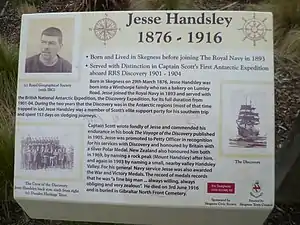 Memorial Plaque | |
| Born | 29 March 1876 Skegness, Lincolnshire, England |
| Died | c. 3 June 1916 (aged 40) Gibraltar, British Overseas Territory Whilst serving on HMS Swiftsure |
| Buried | North Front Cemetery, Gibraltar |
| Allegiance | |
| Branch | Royal Navy |
| Years of service | 1893–1916 |
| Rank | Petty Officer |
| Unit | HMS Swiftsure |
| Expeditions | |
| Awards |
|
| Spouse(s) |
Emily Robinson (1873-1919)
(m. 1909) |
| Children | Herbert Jesse Handsley (1910-1963) |
| Relations | John Handsley (1840-1922) (father) Rebecca Raithby (1857-1883) (mother) Charles John Handsley (1874-1960) (brother) Fred Handsley (1877-1965) (brother) |
Jesse Handsley (29 March 1876 – c. 3 June 1916) was an able seaman who served with distinction under Captain Robert Falcon Scott on Scott's first expedition to the Antarctic regions; the Discovery expedition of 1901 to 1904.
Handsley joined the Royal Navy on 24 December 1901, at age 15.[1] Whilst serving on HMS Ringarooma at Port Chalmers, New Zealand, he joined the British National Antarctic Expedition (the Discovery expedition).
During the expedition, he was chosen by Scott as a member of an elite support party for Scott's Southern trip.[2] Handsley served the full duration of the expedition, most of that time the ship was trapped in the ice. He undertook a number of sledging journeys spending a total of 153 days man-hauling sledges.[3]
Early life
Family
Born in Skegness, Lincolnshire to a long established Lincolnshire family, he lived in Winthorpe and Wainfleet[4] Lincolnshire until becoming a baker boy, worked and lodged in Lumley Road, Skegness (1891).[5]
He lived with his father John Handsley (fisherman) and mother Rebecca Raithby. He was the middle son of three boys. His elder brother Charles John Henry and younger brother Fred. Following the death of his mother in 1883, his father continued to raise the children until Jesse joined the Navy in 1894.
It is likely that the children were educated as it was noted that most of the men on Discovery could read and write,[6] their father John had to make his mark on his marriage certificate but both Charles and Jesse signed their marriage certificates.
Charles was named as next of kin when Jesse joined Discovery.[7]
Early naval career
Handsley, who enlisted in the Royal Navy at the age of 15 in 1891, finished his basic training in January 1893. At the age of 18, he enlisted for 12 years of duty in 1894. By 1895, he had completed his training to become an able seaman and was certified as a Seaman Gunner.
Service number: 164549
Table 1: Demographic characters
| Height | Age | Year |
|---|---|---|
| 5'3 1/2 | 15 | 1891 |
| 5'7 1/2 | 18 | 1894 |
| 5'10 1/2 | 29 | 1905 |
Table 2: Training
| Date | Ship | Type/(Year) | Rank |
|---|---|---|---|
| 23 Oct 1891 | HMS Impregnable | Training ship based at Devonport (1862) | Boy
2nd class |
| 1 Nov 1891 | Lion | Small sail training brig
Tender to Impregnable | |
| 10 Nov 1891 | Boy
1st class | ||
| 20 Jan 1893 | HMS Boscawen II (previously Minotaur renamed 1893) | Shore training establishment at Portland, using a number of ships | |
Table 3: Service at Sea
| Date | Ship | Type | Rank | Note |
|---|---|---|---|---|
| 21 Aug 1893 | HMS Mersey | 2nd class cruiser | Boy, 1st class | |
| 29 Mar 1894 | Ordinary Seaman | Age 18 signed on for 12 years | ||
| 20 Apr 1894 | HMS Pembroke (1891) | Royal Naval Barracks, Chatham | ||
| 18 May 1894 | HMS Ruby (1876) | Screw Cruiser 3rd class - training | ||
| 3 Oct 1894 | HMS Pembroke (1891) | Royal Naval Barracks, Chatham | ||
| 24 Oct 1894 | HMS Edinburgh | Battleship | ||
| 15 Dec 1894 | HMS Galatea | Orlando-class armoured cruiserr | ||
| 1 Apr 1895 | Able Seaman | Fully trained | ||
| 21 Sep 1895 | (HMS Wildfire (shore establishment) | Established at Sheerness (1889) | Qualified as Seaman Gunner | |
| 3 Mar 1896 | HMS Pembroke (1891) | Royal Naval Barracks, Chatham | ||
| 17 Mar 1896 | HMS Collingwood | Admiral class battleship | 10 days cell punishment*, reduced to the 2nd class for conduct, Seaman Gunner qualification suspended | |
| 5 Nov 1896 | ||||
| 9 Mar 1897 | HMS Royal Oak | Battleship | 14 days cell punishment, reduced to the 2nd class for conduct, Seaman Gunner qualification suspended | |
| 31 Mar 1899 | HMS Pembroke (1891) | Royal Naval Barracks, Chatham | ||
| 18 Oct 1899 | (HMS Wildfire (shore establishment) | Established at Sheerness (1889) | ||
| 23 Feb 1901 | HMS Ringarooma (1889) | Pearl-class cruiser, renamed Ringarooma (1890) | ||
| 24 Dec 1901 | RRS Discovery (1901) | Purpose-built for Antarctic research |
- His service records did not show the reason for his punishment. Days in cell punishment did not count towards time in the service, Jesse signed up for 12 years of continuous service from his 18th birthday but would have to serve 12 years and 24 days.
- He was roused half an hour early for being in the 2nd class for conduct,[8] given extra work, reduced pay, only allowed shore leave once a month and his tot of rum (daily allowance since his 20th birthday) was stopped. He lost another two penny a day from his pay for the disqualification of his Seaman Gunner.
Discovery Expedition, 1901–1904
Expedition of the Heroic Age
The Discovery Expedition was undertaken during the Heroic Age of Antarctic Exploration. Setting sail in 1901, Discovery arrived in Antarctica in early 1902 establishing a base at McMurdo Sound. The purpose of the expedition was to undertake scientific and exploratory research and sledging journeys.
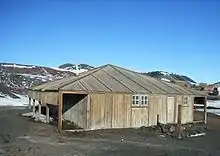
A hut (known as the Discovery Hut) was erected, intended as accommodation for the men but it proved to be too cold so the ship became their living quarters and base camp.
Around a dozen names have been found at the Discovery Hut, among these are Weller, Cross and Handsley, all from Scott's original Discovery expedition.
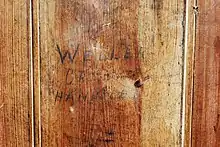
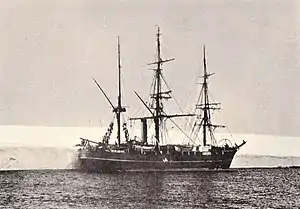
On the voyage to Antarctica, sea water seeped into the ship's hold and a well received joke during a show put on in the Discovery Hut was "what vegetable did the Discovery bring from England'?", "The Dundee Leak".[9] The condition of food stored in the hold was checked on a daily basis. During the winter of 1902 the ship became frozen into the ice. The relief ship SY Morning arrived with supplies and several of Discovery's crew returned to England aboard the Morning, although the majority remained and the expedition was extended for another season.
In late 1903 the Morning returned with the Terra Nova with explicit orders to bring back all the expedition members if the Discovery could not be freed. The Discovery crew sighted the two relief ships on 5 January 1904.
.jpg.webp)
Scott and his crew did not relish the prospect of abandoning Discovery,[10] their home for the last three years and set about releasing her with renewed efforts. Discovery finally broke free and the three ships left Antarctica together.
The voyage from Antarctica was fraught with danger but the expedition finally reached London and the crew were welcomed as heroes. They were viewed as pilgrims of the historic age.
The Discovery, built in Dundee, had many uses in later years including use by the Boy Scouts/Sea Cadets. The ship was saved from the breakers yard in 1979 and restored and is now the centrepiece of Dundee's visitor attraction at Discovery Point, Dundee.
The crew
Of the 48 crew members, all but two returned home.
Handsley joined the expedition by fate, volunteering following a tragic accident[11][12] when Charles Bonner fell from above the crows nest to his death whilst Discovery was leaving Littleton, New Zealand, he was relieved from his naval duties on HMS Ringarooma.

The other tragedy of the expedition occurred in Antarctica when George Vince slid to his death over a precipice into the water[13] whilst wearing fur boots which were the wrong type of footwear for the conditions.[14] A cross still stands to his memory on the summit of Hut Point.
Tom Crean (explorer), also a volunteer from the Ringarooma, was a member of three major Antarctic expeditions including Scott's fatal expedition to reach the South Pole (1911–1913).
Handsley joined two other Lincolnshire men on the expedition:
Reginald Skelton born at Long Sutton, Lincolnshire, who supervised the building of Discovery and was Chief Engineer and official photographer on the expedition.
Arthur Harry Blissett born in Grantham, Lincolnshire, (Royal Marine) was a ward room steward and domestic on the expedition. Arthur completed 30 days sledging and undertook research into Emperor penguins. Arthur got married at Littleton and returned with his new bride to England until emigrating to New Zealand in 1922.
In 1904, the Polar Medal was inaugurated for members of the expedition. Bronze Polar Medals were awarded to members of the crew who returned home on the Morning, Silver Polar Medals were awarded to those who served for the full term of the expedition, with Gold medals being presented to those with outstanding achievements on the expedition. It was also awarded to the crews of both rescue ships, Terra Nova and Morning.
Handsley’s contribution
Handsley undertook a number of sledging journeys spending a total of 153 days man-hauling sledges.[3]
From the record of medals (Royal Geographical Society):[3]
"Always willing, always obliging and very zealous"
| Date | Days | Detail | |
|---|---|---|---|
| (1) | 3 Feb 1902 | 25 | Over the barrier with Armitage |
| (2) | 29 Oct 1902 – 22 Nov 1902 | 25 | With Lieutenant Barne |
| (3) | 29 Nov 1902 – 19 Jan 1903 | 21 | Armitage's Inland Journey |
| (4) | 12 Oct 1903 – 21 Oct 1903 | 20 | Western Journey with Scott |
| (5) | 26 Oct 1903 – 16 Dec 1903 | 22 | The Great Inland Journey with Skelton |
(1) 3 February 1902. Handsley journeyed over the barrier with a party lead by Lieutenant Armitage,[15] under instruction to return within 24 hours. In the haste to leave, a tent was left behind and 5 of the party of 6 occupied a 3-man tent whilst the 6th, Bernacchi, slept outside. The surveying party left the next morning, Handsley, who was not yet adept on skis returned to camp after 11 miles. By the time the party arrived back at Discovery they had learnt a great deal more about the barrier.
(2) With Lieutenant Barne
(3) 29 November 1902 to 19 January 1903 - Armitage reached the summit of Victoria Land on his 2nd attempt.[16] A surveying party of 21 men, made up of two parties. The Main Western Party (12 men including Handsley) with 10 sledges and over 1,300 lbs of food, less than 2 ½ lbs per man per day and the Western Support Party (9 men). On 15 December they started a descent, lowering sledges down a 40° slope, some of the party losing control, Handsley and Walker brought down their 9ft sledge without incident following in the tracks of the others. Christmas lunch was Welsh rarebit and bacon on biscuits. They reached the summit on 28 December and returned to Discovery on 19 January 1903.

(Not shown in table) 9 September 1903. Scott, Skelton, Daily, Evans, Lashly and Handsley form a party to find a new road to the Ferrar Glacier, and place a depot ready for a great western journey over the ice-cap.[17]
The party encountered a blizzard and were delayed in reaching the New Harbour until 13 September. They spent an anxious night on 14th when temperatures dropped to -49°. By 16 September they reached Cathedral Rocks, deposited provisions and set out for home, the temperature had fallen below -50° each night, they reached Discovery on 20 September 1903.
(4) 12 October 1903 – 12 men – Journey to Summit of Victoria Land and as far as could be reached in the time limit. The advance party were to proceed and the remainder to turn back.[18] The parties would pick up food from the depot at Cathedral Rocks. They reached the Knob Head Moraine in 6 days, making better progress than the 27 days it had taken Armitage's party in September 1903.
(5) 22 November 1903 the party split and Handsley, who was used to working at sea level, had been undertaking work at (∓) 8,500 feet,[19] was suffering at the high altitude with his chest.[20] Scott praised him for his determination to carry on saying "they won't give in till they break down, and then they consider their collapse disgraceful", but it was decided that he and two others would return to Discovery whilst Scott, Evans and Lashly would continue on, returning to Discovery on Christmas Eve.[21] where they found Jess still recovering[22]
Escape from the ice. 31 December 1903 - Handsley was now recovered and joined the sawing camp which was set up to saw through the great ice-sheet which intervened between the Discovery and the sea.[23] Due to conditions the sawing had to begin in the middle of the ice sheet, not at the edge. Work had been ongoing for 10 days, the 30 men were working in temperatures of up to -36° and sleeping in tents. To make a channel a mile in length they had to cut through four miles of ice. Twenty miles of ice still encased Discovery.
Scott decided that they should prepare for another winter and Handsley with three others set about raids on the penguins to ensure a winter food stock. On 28 January 1903, Discovery started creaking and moving in the ice and on 5 February, Scott decided to use explosives to free her. By 15 February, the Morning and the Terra Nova break through and lie almost side by side with Discovery,[24] and on 16 February Discovery was freed.
Return to naval duties
Postings
Following the Discovery Expedition, Handsley was given advancement to Petty Officer 1st class without going through the intermediate rate of Leading Seaman.
| Date | Ship | Type | Note |
|---|---|---|---|
| 1 Oct 1904 | Pembroke I | Royal Naval Barracks, Chatham | |
| 7 Jun 1905 | HMS Wildfire (Shore establishment) | Established at Sheerness (1889) | General duties |
| 3 Aug 1905 | Pembroke | Royal Naval Barracks, Chatham | General duties. Presented with Silver Polar Medal (1904) (No.20)[25] |
| 4 Sep 1905 | HMS Merlin | Sloop | Deprived of 2 good conduct badges[26] in 1907 & 1908 |
| 22 Apr 1909 | Pembroke I | Royal Naval Barracks, Chatham | 8 months, the first month or so of shore leave would have been for foreign service leave |
| 10 Dec 1909 | HMS Ganges | Training establishment, Shortly | Petty Officers of a high standard were drafted to training establishments |
| 1 May 1010 | Ganges II | Old ships at training establishment | |
| 6 Apr 1911 | Pembroke I | Royal Naval Barracks, Chatham | Awaiting draft to next ship |
| 26 May 1911 | HMS Shannon | Armoured cruiser, flagship of the 2nd Cruiser Squadron, | |
| 21 Jan 1913 | Pembroke I | Royal Naval Barracks, Chatham | |
| 8 Feb 1913 | HMS Shannon | ||
| 10 Mar 1914 | Pembroke I | Royal Naval Barracks, Chatham | |
| 15 Apr 1914 | HMS Triton (1882) | Small surveying vessel | Carrying out surveys in Home Waters |
| 4 Aug 1914 | Pembroke | Royal Naval Barracks, Chatham | |
| 28 Nov 1914 | HMS Wallaroo | Inactive guardship at Chatham | |
| 19 Mar 1916 | Pembroke I | Royal Naval Barracks, Chatham | Awaiting draft to next ship |
| 3 May 1916 | HMS Swiftsure | Pre-dreadnought battleship | |
| 3 Jun 1916 | Royal Naval Hospital Gibraltar | Discharged Dead. Cause of death: gastric ulcer | |
Promotions and conduct
Handsley's conduct was assessed each year, mostly as good, but he served at least two sessions of cell punishment during his 23 years service[27] He was awarded two good conduct badges but was deprived of them both before having them both restored. It took him 17 years to get his third badge, 5 years longer than the usual 12 years. His service record does show that his conduct was assessed as very good towards the end of his tragically short life.
Personal life
Handsley married Emily Robinson[28] in 1909 and they had one son, Herbert Jesse Handsley. Emily died in 1919. Herbert never remarried and spent his later life in Chalfont Epilepsy Colony[29] until his death in 1963.
His brother Charles married Lydia Annie Davis (1898)[30] and had a daughter, Millicent Emily Handsley (1899).[31] The family line continues today.
Posthumous recognition
| Quartermain Mountains | |
|---|---|
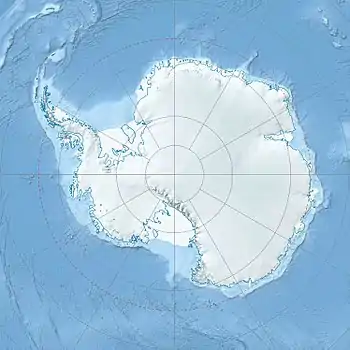 | |
| Geography | |
| Continent | Antarctica |
| Range coordinates | 77°51′S 160°45′E / 77.850°S 160.750°E |
In addition to the Silver Polar Medal (1904) awarded for his time serving on Discovery, Handsley was awarded the 1914-1915 Star, the British War Medal and the Victory Medal. His Polar Medal was sold at Sotherby's to a private collector on 2 July 1980.[32] His war medals were sold by auctioneers Dix Noonan Web on 4 December 2008.[33]
Mount Handsley, named in 1969 by the New Zealand Antarctic Place-Names Committee in recognition of his efforts on a major sledging journey with Scott, Evans, Feather Skelton and Lashly Evans up the Ferrar and Taylor Glaciers in 1903.
Handsley Valley, is a small ice-free valley between Knobhead and Mount Handsley in the Quartermain Mountains of Victoria Land, Antarctica. It was named by the New Zealand Geographic Board in 1993 in association with Mount Handsley.
Jesse Handsley Memorial, Compass Gardens, Skegness, Lincolnshire, 21 March 2016.

In the centenary year of his death Handsley was honoured by Skegness, the town of his birth, when Mayor Councillor Carl Macey unveiled a tribute board, sponsored by Skegness Town Council and Skegness Civic Society, to the "son of Skegness".
Also attending were representatives of Grantham Civic Society who had recently honoured their 'son of Grantham' by placing a blue plaque on the birthplace of Royal Marine Arthur Harry Blissett, ward room steward on Discovery.
The unveiling was followed by a dedication and blessing on 8 May 2016 by the Reverend Ian Banks.
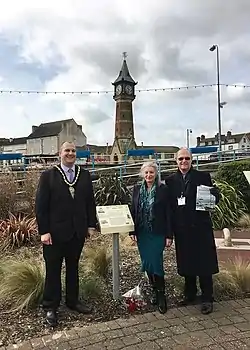 Jesse Handsley Memorial unveiling March 2016 Mayor of Skegness, Councillor Carl Macey, Jane Handsley & Courtney Finn of Grantham Civic Society |
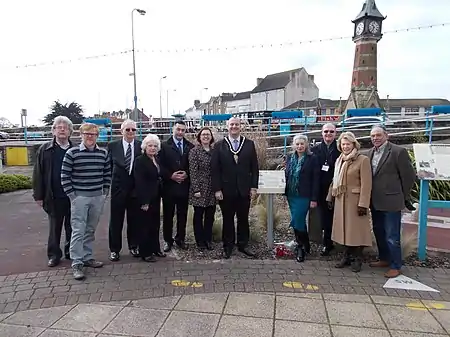 Jesse Handsley Memorial Unveiling. Representatives of Skegness Town Council, Skegness Civic Society and Grantham Civic Society |
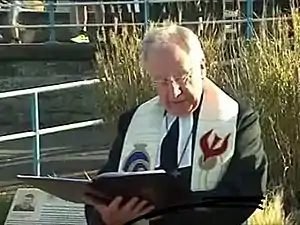 Jesse Handsley Memorial Blessing, May 2016, the Reverend Ian Banks |
Final resting place, North Front Cemetery, Gibraltar
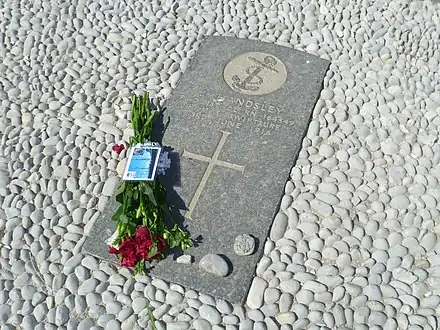 Jesse Handsley
Jesse Handsley Rock of Gibraltar viewed from graveside
Rock of Gibraltar viewed from graveside Aerial view of cemetery indicating grave
Aerial view of cemetery indicating grave
References
- ↑ RGS IBG Collections AA/3/4/37
- ↑ Scott, Captain Robert Falcon (1905). The Voyage of the Discovery, Vol I. Smith, Elder & Co. p. 205.
- 1 2 3 Record of Medals RGS AA/3/1/22. Pg 24
- ↑ 1881 Census RG11/3254 pg.19
- ↑ 1891 Census RG12/2604 pg.22
- ↑ Baughman, Tim H (1999). Pilgrims on the ice. University of Nebraska Press. pp. 130. ISBN 9780803212893.
- ↑ Reference Sheet RGS AA/3/4/36
- ↑ Queen's Regulations and Admiralty Instructions, Chapter 36, Discipline and Conduct - General
- ↑ Baughman, Tim H (1999). Pilgrims on the ice. University of Nebraska Press. pp. 144. ISBN 9780803212893.
- ↑ Scott, Captain Robert Falcon (1905). The Voyage of the Discovery, Vol I. Smith, Elder & Co. p. 327.
- ↑ Yelverton, David E (2000). Antarctica Unveiled. University Press of Colorado. p. 97.
- ↑ Scott, Captain Robert Falcon (1905). The Voyage of the Discovery, Vol I. Smith, Elder & Co. pp. 113, 114.
- ↑ Scott, Captain Robert Falcon (1905). The Voyage of the Discovery, Vol I. Smith, Elder & Co. p. 235.
- ↑ Scott, Captain Robert Falcon (1905). The Voyage of the Discovery, Vol I. Smith, & Elder Co. p. 237.
- ↑ Yelverton, David E (2000). Antarctica Unveiled. University Press of Colorado. pp. 115 & 117.
- ↑ Yelverton, David E (2000). Antarctica Unveiled. University Press of Colorado. pp. 201, 207 to 217.
- ↑ Scott, Captain Robert Falcon (1905). The Voyage of the Discovery, Vol II. Scott. Smith, Elder & Co. pp. 205 to 209.
- ↑ Scott, Captain Robert Falcon (1905). The Voyage of the Discovery, Vol II. Smith, Elder & Co. p. 220.
- ↑ Yelverton, David E (2000). Antarctica Unveiled. University Press of Colorado. p. 299.
- ↑ Scott, Captain Robert Falcon (1905). The Voyage of the Discovery, Vol II. Smith, Elder & Co. pp. 255, 256.
- ↑ Scott, Captain Robert Falcon (1905). The Voyage of the Discovery, Vol II. Smith, & Elder Co. p. 295.
- ↑ Scott, Captain Robert Falcon (1905). The Voyage of the Discovery, Vol II. Smith, & Elder Co. p. 296.
- ↑ Scott, Captain Robert Falcon (1905). The Voyage of the Discovery, Vol II. Smith, Elder & Co. pp. 308 to 316.
- ↑ Scott, Captain Robert Falcon (1905). The Voyage of the Discovery, Vol II. Smith, & Elder Co. p. 350.
- ↑ Public Record Office ADM/171/61
- ↑ Kings Regulation & Admiralty Instructions 1906, Sections III -IIV
- ↑ National Archive ADM/188/244/164549
- ↑ England & Wales, FreeBMD Marriage Index, 1837-1915 vol 2a pg 1004
- ↑ 1939 England &Wales register. pg 12
- ↑ England &Wales, FreeBMD Index, 1837-1915. vol 6a pg 581
- ↑ Gloucestershire, England, Church of England Baptisms 1813-1913. pg 65
- ↑ Sothebys auction catalogue, 2 July 1980 (lot 119)
- ↑ Dix Noonan Web auction catalogue, 4 December 2008 (lot 1127)